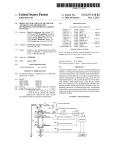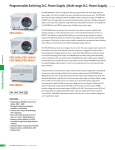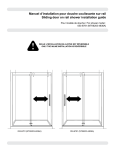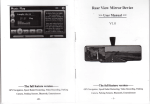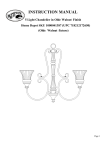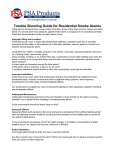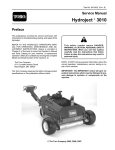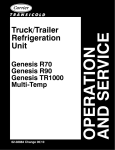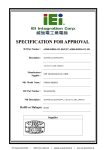Download DUCT - spiru.cgahr.ksu.edu
Transcript
5th I11t. Working Conf on Stored Products ProtectIOn, Bordeaux, France; September 1990.
DUCT: A PC Program for Sizing and
Evaluating Grain-Store Ducts!
S.G.WILSON
Stored Grain Research Laboratory (SGRL), CSIRO Division of Entomology,
PO Box 56, Highett, 3190, AUSTRALIA.
Abstract-In the past, seed-store ducts have usually been designed by use of velocitylimiting-rules and guess work, rather than by predictive methods. To make a predictive
method accessible1to designers we have developed program DUCT. It is an easily used IBM 2
Personal Computer (PC) or PC compatible program that predicts velocity and pressure
distributions, and determines duct flow uniformity and fan pressure load, for seed-store
ducts. Program DUCT can also find the smallest duct lize that achieves a specified flow
uniformity, or, fan pressure load. This enables designers to readily optimize their duct
design by finding the Imallelt duct lize that achieves an acceptable flow uniformity or fan
pressure load. This paper describes the features of program DUCT and considers some of
the factors influencing selection of the program's input values.
Introduction
PrevIOus ~Vol'k
Computer models capable of predicting seed-store duct performance (see, for example, Shove
and Hukill, 1963; Marchant and Nellist, 1977; Burrell et al., 1982), have existed for some time.
However, these predictive models have not been made widely available to duct designers. Duct designers have therefore based their designs on velocity-limiting-rules (Shove; Brook, 1979; Navaro
and Calderon, 1982; Hellevang, 1984). These rules attempt to maintain uniform duct flow by
keeping duct longitudinal and face velocities below set limits. For common geometries such
as rectangular or circular stores, a number of computer programs have recently become available (Bridges et al., 1988; Greenwood, 1988; Prive, 1989) that automate the use of these rules.
Consequently, seed-store ducts continue to be designed using velocity-limiting-rules and Without
pl'edlclzng the velocity and pressure drop distribut,ions along the duct.. Problems can arise from
this approach, particularly for long ducts.
AWlS
The main aims of this work are:
1. to make widely available1to duct designers an easily used IBM 2 Personal Computer (PC)
or PC compatible computer program (program DUCT) that allows them to predict the air
velocity and pressure distributions occurring along seed-store ducts; and
2. to set-up program DUCT to funct.ion as a deslgll tool that allows designers to easily find the
smallest (and cheapest) duct size needed to attain a specified duct flow uniformity, or fan
1 Program DUCT is available for purchase from SGRL.
2mM is a trade mark of International Business Machine Corp.
- 1833 -
pressure load. Conventional predictive methods only evaluate the performance of a duct of
already known duct-size and must be used iteratively to optimize duct size.
Features of the Program
Program DUCT:
• enables design of aeration and fumigation ducts,
• in vertical and horizontal seed-stores,
• of any floor plan and any duct lay-out; and
• applies to packed or unpacked seed and
• to suction and blowing ducts.
The program employs stable numerical methods that enable it,s calculations to take only a
few minutes on a basic PC. The program includes an on-line help facility that explains how to
select its input values. The program's User Manual expands on the material included in this
paper, and explains how to design duct-layout.
'
The program also plots graphs to enhance the user's understanding of its results, These
graphs show the variation of air pressure, and longitudinal and face velocities along the duet..
The graphs, and all text output from the program, can be saved and printed. For blowing duets
in aeration systems, the program also calculates the temperature rise through the fau.
Tables 1 to 5 included in the program's User Manual (Wilson, in press) and in the programs
on-line help, give values ebablingthe program to be used for a witle variety of grains, oilseeds, and
legumes and for common seed-store and duct materials. The program applies to seven common
duct geometries, these being:
• round ducts,
• half-round ducts,
• above floor rectangular ducts,
• in-floor rectangular ducts,
• split in-floor rectangular ducts,
• shedder plate ducts, and
• cornel' ducts.
Duet Flow Uniformi1.y and Fan Pressure Load
Two factors that are very important to the design of duets are:
1. the flow uniformity along the duct, and
2. the amount of pressure that the fan needs to generate in order to force the air along the
duct and through the seed bulk. We call this pressure the fan pressure load.
1. Duct Flow UnIformity, -r-As ail' flows along a duct, some of it must also pass through
perforations in the duct face to aerate or fumigate the seed bulk. The flow rate through t,he
duct face is called the face velocity, u, m/s.
Ideally, to ensure that seed at one end of the duct does not receive more aeration of fumigation treatment than seed at the other end, the face velocity should be the same at any point
- 1834 -
along the <duet. This ideal of complete flow uniformity cannot be achieved unless the duct
is very hugE' and expensive, so, in practice, we usually strike a compromise by accepting a
reduced flow uniformity in return for a smaller less expensive duct.
Program DUCT calculates the duct flow uniformity,
7", -
(that is, dimensionless3 ), as
Un.in
( 1)
7":: - - ,
Urn,..,
where the subscripts ma.2l and min indicate the largest and smallest
that occur along the duct.
'U
values, respectively,
Velocity-limiting methods of duct design do not allow you to determine the duct flow uniformity and this is precisely why they can cause problems in design of long ducts.
2. Fan Pressure Load, r-The fan pressure load arises from two sources:
(a) The pressure drop caused hy the height. of the seed that the air passes t.hrough. This
pressure drop is unavoidable and is the minimum possible fan pressure load, rrnin.
(b) The pressure drop caused by constriction of the flow field around the duct. This value
is effected by the size of the duet.
Program DUCT takes into account both of these pressure drops and allows you to use a search
mode (explained below) to optimize the pressure drop caused by flow constriction.
Et'a/uatlOtI and Search Modes
There are two sit.uations commonly faced by duet designers:
1. For existing ducts, they need to el'aluaie whet.her those ducts are suitable for a particular
application.
2. When designing new ducts, they need to be able to find the optimum sl::e needed to achieve
satisfactory duct performance.
To meet these needs, program DUCT can be used in two modes:-
r,
1. Evaluation mode-finds the duct flow uniformity, 7", and fan pressure load,
Pa, that
occur for a specified duet cross-sectional area, A, m 2 . You can use evaluation mode to
decide if existing ducts are adequate or would be useful in new circumstances.
2. Search mode-determines the smallest duet area, A, needed t.o attain a specified 7" value,
or, a specified 1= value. As above-floor duct costs increase at somewhere between the squa.re
and the cube of the duct width, even small reductions in duet size can give considerable
cost savings. You can use search mode to deSIgn new ducts.
After the search, program DUCT allows you to interactively choose, from duct sizes you have
available, a size nearest to that found by the program's search. The program will then
evaluate the performance of the chosen duct size.
Below, in the section titled "How to Optimize Duct Design," we explain how to use search
mode.
3 A. each new variable i. introduced, it. dimen.ion. (that i., ita unita) are al.o given. Where a variable i.
dimenaionle.., this i. indicated by a hyphen, -.
- 1835 -
Selection of Input Values
Treatment Rate (of air or fUllllgant)
We use the term treatment rate to refer to the flow rate of aeration air or fumigant through
the seed. Program DUCT allows for three different types of treatment:- aeration, recirculating
fumiga (,ion and flow-through fumigation. For each type of treatment there is a different way of
specifying t,he treatment rate:.'1emtlOlI Systems: SpeCific Air Flow Rate, Q, As seed-stores become taller, it is necessary
to iucrt><lse the upward air velocit,y to ensure that the time for the air to traverse (,he height of
(,he store, ttlir, S, is maintained at about the same value.
This adjustment can be made automatically, regardless of store geometry, if t.he I.reatmenl.
rate is specified using a speCIfic air flow rate, Q" l/s-I,OIllH,-. Q, is called a sllecific flow rate
because it is the flow rate per mass of seed. If we take the bulk density of the seed as Pg, kg/m 3 ,
the mean height in the store as H.eed, m, and the floor area of the store served by the duct as
A, ... ed' m 2 , then we can readily show that the air velocity in the vertical direction, v.ertiea/, mis,
IS:
V..rtieal
= 1 X 10- 6
X
pg H,eed Q"
(2)
and I,he time for the air to t,raverse (pass through) the height of the store, t a .. , sec, is
t air =
1 X 10 6
pg Q, ,
(3)
Consequently, when we define the treatment rate using a speCIfic air flow rate, this automatically ensures that.:
• I,he vertical velocity, V.erliea/, is proportional to the seed height (equation 2),
• all geometric factors (floor area and height) cancel out leaving the time for t.he all' to
I,raverse the height of the store. tair, dependent only on the specific air flow rate, Q,. and
the bulk seed density, Pg (equation 3). and as pg is roughly cons(,ant,
• the air traverse time,
tair, IS
dcterml1led by the specific air flow rate.
ate that there is a difference between the air traverse time and the time for a cooll1lg frollt
to traverse the seed. The traverse time for a cooling front is much greater than the air traverse
I,imp because it takes a large volume of air to cool a little seed. The cooling fronl, traverse time
depends on a number of fadors including the air traverse time, the seed type, the seed moisture
contput and the initial seed temperature.
As shown in ParI, 2 of the SGRL Aerat,ion Manual (Wilson, in press), conservative design
temperature and moisture conditions can be chosen that allow selection of a design specific air
flow rate value, Q" de,ig", that ensures an acceptable maximum aeration cooling time, teooli"g,
under worst case conditions. For example, for aeration of wheat in cooler parts of Australia, we
aim for a maximum cooling time. teooli"g, of 5 weeks and recommend Q" de,ig" values of U.\/5
lis-tonne for horizontal stores and 0.6 lis-tonne for vertical stores.
RCC1.7'Cldatlllg FumigatlO1I Systems: Alr-('hallgr Tl/IIC, H r For rpcirCltla(,ing fumigation systems. program DUCT specifies the fumigation treatment rate by thl:' uUllIbpr of hours takl:'n to
r..circulate the air in the store, H r , hours/air-chang...
Flow-TIII'ough Fum/gatlOu Systems These systems wnt low fUl1li~aut cOlIcputrat.ions through
au unsealed seed-store t,o atmosphere. Duriug this process, fumigaut, couceutratious are costeffecf,ively maintained al. a sufficient concenl,rabon over a time t,hat kills all insect phases. The
program automatically calculat.es t.he appropriate treatmpnt rate for >'OU when flow-through fumiga(,ion systems are selected.
Recommelldcd Vailles of Duct Flow [TII/formlty. T.
The ratio of the height to the width of a store is importanl, because it affect.s the uniformity
of flow through the seed bulk.
- 1836 -
Th€' flow t€'nds to b€' more uniform in t,all narrow stor€'s, which we call vertical st,ores, than
it is in wid€' squat; st,ores, which w€' call horizontal stores.
To d€'cide wh€'ther a store is v€'rt,ical or horizontal we suggest use of the following rule:
A vertIcal store has a mean grain depth, Hgrain, greater than or equal to twice the
square root of the total floor area of the store, A,tore' If the store doesn't sat,isfy this
condit,ion, it is a hOrlzon/al store.
Alg€'braically, th€' store is v€'rtical if:
2)A ltore ,
(4)
Hgrain<2)A,lore.
(5)
Hgrain 2:
and th€' stor€' is a horizontal if:
B€'cause th€' flow tends to b€' mol'€' uniform in v€'rt.ical stores than it is in horizontal ston's,
th€' duct flow uniformity, T, need€'d to achiev€' good flow uniformity in th€' seed blllk, dep€'nds
upon th€' seed-store type. For:• horizontal seed-stores you need high
treatment, and for
• vertical seed-stores you can use lower
You can have lower values of
values, for example
T
T
T
=0.9, to assure uniform seed
valu€'s, for example, 0.5
~ T ~
0.9.
for vertical stores becaus€':-
T
- away from the duct, the flow redistributes and becomes more uniform, Consequently,
low flow regions at one enu of the duct, affect only seed in t,he region of the uuct. Flow
redistribution usually occurs within a h€'ight about equal to t.he width of the store.
- provided the seed treatment rat€' is determined by a speCIfic air flow rate, Q" then
the vertical velocity is proportional to the height of the st.ore (equat.ion 2). As vertical
stores have a, greater height, than horizontal stores, the vert.ical velocity in such stores
is also higher. Consequently, even if there is a low€'r flow rate region at one end of
the duct, the vertical velocity in that region is still high enough to ensure satisfactory
treatment. Clearly, if the vertical store only JUst. satisfies equation 4, t.hen T should
be doser t.o 0.9 than to 0.5. As the height increases beyond 2y'A,tore, so T can be
reduced toward 0.5.
T lIalliCS 1.11 ElIallin/1011 AIode In evaluation mode, the program calculates the flow uniformit,y,
achieved by a duct. of specified size. Although you can make your own judgements as to wllf'ther
t,he T value is acceptable, t,he prograrn will also advise you as to wheth€'r th€' T valu€' sa.t.isfi€'s th€'
following recomm€'nd€'d ranges:
T,
Table 1: Sat.isfactory
Ston' Type
T
Ranges when Evaluatin!!, Duct P€'rformance
Height Rang!:'
Satisfactory T Rang" according
to Store (;"0l1l€'try
~ T ::;
Horizontal
0.8i
Wide Vertical
-0.2 .
!A
v
Narrow Vertical
- 1837 -
D.\:>3
lCCtl
dare
+ 1.2i ~ T ~
0.93
T t'aille.~ III Search Mode
In Sparch modp, t.hp program sf'archps t.o find tilt' duet. arl'a that.
achieves a specified flow uniformity, T. The T value must. therefore 1)(:' specified before the program
can begin its search. You can:
• specify your own
T
value, or
• have the program automatically specify a.
Table 2: Search
Store Type
T
T
value according t.o the following:
Values according to St.ore Geomet.ry
Height. Range
Value used in
t.he Search
T
Horizont.al
-0.2
Wide Veltical
Narrow Vert.ical
H,eed
> 4y'A,tore
Hmd
y'A. toTe
+1.3
0.5
How fo Allow for Seed Packwg
Seed packing causes closure of t.he spaces bet.ween t.he seeds. This rest.ricts t.he flow of air
t.hrough t.he seed increasing the pressure load on t.he fan and making it more difficult. t.o t.reat
the seed. Packing of seed occurs over t.ime because of compression caused by t.he weight. of t.he
seed above thl' duct.. Vibration, for example, from passing t.rains or unbalalH'ed fan 1110t.ors, also
increases packing. Program DUCT allows t.he designer eit.her to ignore seed packing or t.o specify
t.he % of packing. Allowance for up to 30% packing is recommended where sped is to be st.ored
for lengt.lly periods.
How to Optimize Duct Design
If a duct is unnecessarily large, it, will perform well but. it will be expensive. If a duct is
t.oo small its performance will not. be satisfactory-the fan pressur.. load will be high, or. 1.I1t'rf'
will be a. non-uniform flow along the duct causing over-treatment. of seed at t.he fan end. and an
insufficient seed treatment at the ot.her end.
A duct. designer's most challenging task is to o]lfwuze the duct sizt'-to find the smallest. duct.
that will give satisfactory flow uniformity and fan pressure load.
To allow you to easily find the optimum duct. size, program DUCT has a sf'arch modf' that can
perform t.wo types of search:
• it can find the duct size, (that. is. dud. cross-sect.ional arf'a) 1.11111. gi\'t>s (I SI)f'cifit>d vallw uf
flow uniformit.y, T, and
• it. can fiud the duct size t.hat. gives a specified value of fan pressure load, :F.
We will refer 1.0 t.hese two searches as t.Ilf' T-search and :F-search. l'espect,iwly.
Recommended Search ProceduT'(
Search mode lUust. be used correctly 1.0 avoid problems. We recommend t.hat. you adopt. t.he
following procedure:
- 1838 -
• Perform a r-search first, t.hereby obtaining t.he duct size needed to achieve the specified
r-value. The r-search will also give values for the fan pressure load occurring with that
r-value, F ... , and the minimum possible fan pressure load, Fmin.
• You 0111.1/ need to perform an F-search if F ... is too high-greater than 1500 Pa.
If F... is less than 150U Pa your design problem is solved, you have already obtained t.he
smallest duct size needed to give the specified flow uniformity, with an accept.able fan
pressure load. You do not need to do an F-search.
If F... is gr'eater' than 15UU Pa, you may be able to obtain a useful reduction in fan pressure
load by changing the duct geometry or making the duct marginally larger. To find out if
t.his is possible, use the program's F-search.
• For t.he F-search, keep t.he F values that. you specify, between F... and Fmin.
Reducing F from F... t.owards F min . will make the duct progressively larger. Consequently,
you nped to balance uuct cost, which is determineu largely by duct size, against fan capital
ami rUllning costs, which are uet.erminetl by F. You will probably need to perform a number
of F-searches t.o allow you to strike this balance.
Effect of Fall Pre.~sllre Load. F
The fan pressure load, F:
• determines both the fan running cost, and
• the temlwrature rise t.hat occurs in the air passing through the fan.,
VVe should therefore ensure that F is not 1I1111ecessanly high. Further, for blowing systpms:
• the temperature rise through the fan belleficwlly lowers the relative humidity of the all'
flowing into the seed, thereby reducing the likelihood of the inlt't air wetting t.he set'd,
• but. it reduces the capacity of tht' at'ration air to cool the seed.
To balance thesp factors, we rt't'Oll111wnd that you try to keep F below 1500 Pa. \Ve have
obtained the value of 150U Pa from our own attempts to balance duct size against fan running
cost. You may wish to use a different value. We have chosen the value of 15UU Pa because:
• prpssure loads below 1500 Pa can rt'adily be met by common efficient centrifugal fans, and
• it givt's a temperature rise of less than 2°C. A 2°C temperature rise:
- provides a useful reduction in relative humidity of the inlet air,
- with an acceptable loss of cooling capacity.
Facial'S Il1ffuellcl1lg all F-search
In performing an F-search, you should keep the following in mind:
1. Fmin is sometimes greater than 15UU Pa.
The minimum fan pressure load, Fmin, occurs when the duct is very large. Then, t.he )W'Ssure load associated with flow constriction around tlH' duet. is minimized and the pressurp
load is almost totally that due to the depth of the seed.
In tall vertical aerated stores, the large seed dppth makes Fmin greatpr than 150U Pa. This
is the price that sometimes has to be paid for the conveniencp and better flow dist.ribut.ion
achievpd by vertical stores.
2. It is 1I0t possible to reduce F below Fmin'
- 1839 -
(a) If :Fmin ~ 1500 Pa, the best you can do is to reduce :F to a value somewhat greater
(say 100 Pa greater) than 'Fmm (but still above 1500 Pal.
(b) If :Fmin < 1500 Pa, we suggest that you try to reduce :F to about 1500 Pa. It may
also be possible to reduce 'F below 1500 Pa. If you do, you should judge whether the
further reduction is worthwhile by balancing duct cost against fan capital and running
costs.
3. :F is influenced by the dnct geometry allli width.
The fan pressure load is determined hy both the seed depth and hy flow constriction around
the duct. If we make the duct larger and wider, this will lessen the flow constriction around
the duct and the fan pressure load will therefore be reduced.
Sometimes, cost-effective reductions in :F can be achieved by making the duct only a little larger and hence wider, or, by changing the duct geometry. Some geometries have a
greater width for a given duct cross-sectional area. For example, switching from an in-floor
rectangular tluct to a split in-floor rectangular duct increases the witlth for the same crosssectional area. Also, for rectangular ducts, you can obtain a greater width by decreasing
the height-to-width ratio of the tluct.
However, you may also find that in obtaining reductions in :F, the duct becomes unaccepl,ably large. You must therefore exercise your own jutlgement as to what is reasonable-you
need to balance factors such as the temperature rise through the fan and duct capital cost,
against fan capital and running costs.
Usually, to keep the duct size and cost reasonable, you will have to accept some flow
constriction around the duct. The best fan pressure load you can achieve will therefore be
somewhat greater (say around 100 Pa greater) than the minimum fan pressure loatl, Fmin.
Note that reducing F by making the duct larger gives a more uniform duct flow.
4. DOll't perform the F-search first.
Normally. you should vary r-values between 0.5 and O.P (as recommended in the section
ahove titled "Selection of Input Values: Recommended Values of Duct Flow Uniformity, r).
Usually, this 0.5 to O.P range of r-values will not cause problems in the program.
However, :F-values vary wldrly anti it is not possible to prescribe a safe limited range of
:F-values, as we can for the r-values. Consequently, if you dOIl't use a r-search first to obtain
F T and :Fmin and then, during the F-search, keep F between these values, you can easily
choose:
• An impossible F-value that is below Fmin (the program will detect this and stop), or
• An :F-value, greater than FT , that is so high that it cannot be obtained without the
program making the duct very small. This is likely to cause an extremely non-uniform
duct flow leading to lllunerical problems in the program (the program shoultl detect
the onset of these problems, warn you of the cause, and then stop).
So starting-off by defining a r-value is safe, but starting off defining an 'F-value (when you
(Ion't know what F-values are reasonable) can easily lead to problems.
Conclusions
Program DUCT provides a number of uniqne and useful features. Firstly, it makes a pre(lictive
method for evaluating duct performan,e available to anyone having arress to an IBM Personal
Computer (PC) or PC ,ompatible. Unlike design programs that use velocity-limiting-rules, program DUCT predi,ts duct performance hy solving the momentum equation governing flow along
seed-store ducts. It also "valuates duct, performan,e by ,alculating tlw fan pressure load, F, and
a new performan,e index, the flow uniformity, r, that is defined in this paper.
- 1840 -
Sf.>condly, program DUCT has two modes of operation, an (lla/uation mode that, predicts the
[wrformance of a specified duct, and a search mode in whirh t.IH' program searches t.o find t.IlP dnd
size needed for a part.icular application. This unique feat.ure allows users to specify t.he desired
duct, performance by selecting a value of duct flow uniformity, T, or fan pressure load, :F. Then
t.he program finds t.he smallest duct size that, achieves t.hat performance. Designers can t.llf.>refore
USf.> search mode t.o size duets.
Thirdly, having regard to needs for versatility, program DUCT can be applied to any duct
lay-out, and st.ore geometry, and t.o seven common duct. geomf.>tries.
This paper:• examines some of the factors that. influence your selection of thf.> program's input. valuf's,
including:
- choice of treatment, rate in bot.h aeration and fumigat,ion syst.ems, including, for aerat.ion syst.ems, the relat.ionship bet.ween air velocit.y through t.he seed and sJ1e('lfic air
flow rat.e,
- a met.hod for deciding whether a st.ore is of a vert.ical or horizont.al t.ype on t.he basis
of t.he rat.io of mean seed height., H .. ed, to the floor-area of t.he st.ore, A,tore,
choice of flow uniformity, T. values according to store geometry:
* in evaluation modf', by recommending a satisfactory range of T values, and
* in search mode, by specifying a T value for use in t.he search, and
allowance for seed packing: and
• explains how to use the program's search mode t.o opt.imize duct. design.
Acknowledgements
The aut.hor is grateful to the Aust.ralian Wheat. Board and t.he Australian Bulk Grain Handling
Authorit.ies for financially sponsoring t.his work.
References
Britlges, T.C. et. al. (1988) An aeratiou duct t1f'sign model for flat. grain-stores. TrailS. A.S.A.E.,
31( 4): 1283-1288.
Brook, R ( 19'j~1) AeratIOn systems fOl' dry gram.AEIS 3\)1, Agricultural Engineering Department., Mich. St.at.e Univ.
Bunell, N..J. et. al. (1982) Air distribut.ion frol11 vent.ilat.ion duct.s under grain. J. ag('lc. £lIgng.
Res., 27(4):337-354.
Greenwood. K. ( H)88) Rf.>designing structures t.o hold surplus grain. Agnc. £lIg11g., (39( 7): 16-18.
Hellevang, K..I. (Hl84) Crop storage 1IIallage1llellt. AE 791, Agricult.ural Engineering Depart.ment, North Dakota State Univ.
l\larchant" J .A. and Nellist" M.E. (l97i) Ail' Pressure and Flow in Duct,ed Crop Drying Systems.
J. ag1'lc. £lIgllg. Res., 22:3U:3-31U.
Navarro, Sand Calclf'ron, M. (HI82) AemtlOlI of Gram III Subtropical Clllllat(~. Food and
Agricultural Organization of t.he {rnit,f'(! Nat.ions, Romp.
Prive, S.A. (HIS!)) Technical pl'Ofilf': Grates for storage aeration. 1l'0l'id Gmtll, S!)(a):18-HI.
Sho\f.>. G.C. (USA) All' Flow AnalYSIS of Gralll r(lItilatlOlI Duets. PhD t.llf.>sis. Iowa Sl.at.t'
llniversity, Ames, Iowa.
Shove, G.C. and Hukill, W.V. (196:~) Predict.ing presslll'f.> graclif'nt.s in p<"rfora.t.etl grain vent.ilat.ion
duct.s. Tl'OlIs. A.S.A.£., 6(21:115-12~.
Wilson, S.G. (in press) Aerat.ion Manual: Part:i Engineering Design. Stored Gralll ReSl'UlTh
Laboratory Publtratwn, CSIRO Division of Ent.omology.
Wilson, S.G. (in press) {rser Manual. DUCT: A PC program for dpsigning, grain-store ducts.
Stol'ed Gralll Research La.boratory PublzcatlOlI, CSIRO Division of Ent.omology.
- 1841 -












